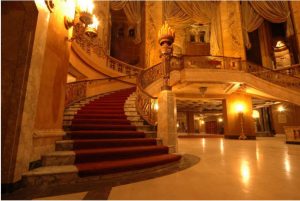Some movie theaters are so beautiful and opulent they’re rightly called movie palaces. Although Chicago was once a movie palace mecca, many have been demolished over the years.
People are buzzing about movie palaces with the release of the documentary Going Attractions: The Definitive Story of the Movie Palace and the plans to restore the once-luxurious Uptown Theatre. Want to see haunting footage of the Uptown? We've got it, and other fascinating material on movie palaces, too.
Great American Movie Theaters is a handy guidebook from the National Trust for Historic Preservation. It features 360 movie theaters from all 50 states, including 29 Illinois theaters such as the demolished Granada Theatre and the lovingly restored Music Box.
The Chicago Theatre on State Street is another beautifully restored movie palace. Repurposed as a performing arts venue, it graces the cover of Downtown Chicago's Historic Movie Theatres, which explores Chicago's earliest movie theaters, the golden age of movie palaces—the 1920s—and beyond.
The Chicago Movie Palaces of Balaban and Katz is packed with photos from the Theatre Historical Society of America and other sources. Chicagoans Balaban and Katz were movie palace pioneers who created some of the largest and most luxurious movie palaces anywhere, often with the architecture firm Rapp and Rapp. Among their theaters were the Southtown Theater, which had a “Flamingo Pool” with live swans, and the Nederlander Theatre (formerly the Oriental) with its enormous domed ceiling, ornate chandeliers and whimsical elephant-head light fixtures. (Side note: Harold Washington Library Center holds the Balaban and Katz Collection of over 26,000 scores for dance bands and orchestras.)
Perhaps the ultimate movie palace was the Uptown Theatre, which closed in 1981. Thankfully, two Chicago area film students made a short documentary about the 46,000-square-foot theater. Uptown: Portrait of a Palace chronicles the theater's spare-no-expense beginnings, its glory days, its second life as a concert hall and its heartbreaking neglect. Although theater historians, volunteers and others speak eloquently on behalf of the Uptown, the true star of the documentary is the theater itself. Halfway through the film you enter the Uptown lobby to the music of Philip Glass. You take in the grand double staircase. The ornate columns. And “a ceiling … so high that it becomes mysterious,” in the words of theater historian Joseph DuciBella. It’s a haunting, jaw-dropping moment in which you suddenly understand the passion of the Uptown Theatre preservationists.
What’s your favorite movie palace? Do you have a favorite memory of the Uptown?



Add a comment to: Movie Palaces: Chicago Architectural Treasures